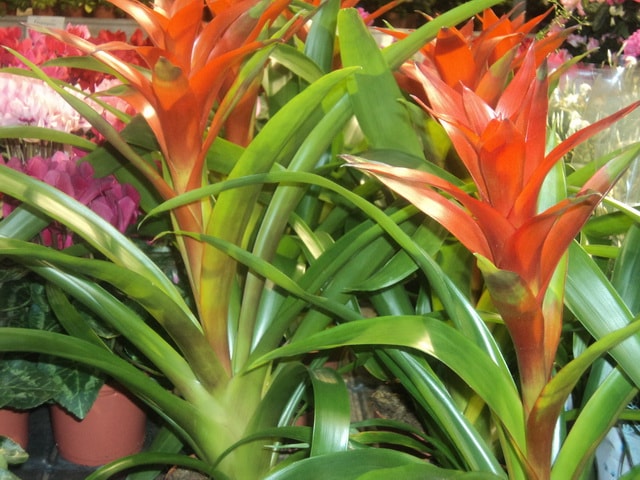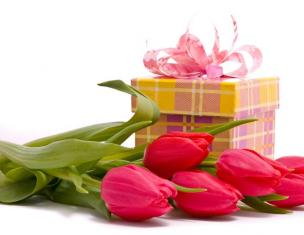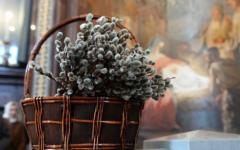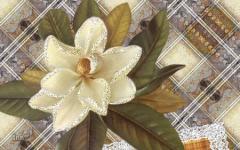Blooming flowers in pots are a wonderful decoration for rooms in an apartment or house, balconies or even summer cottages. This original gift for a birthday, housewarming or other celebration. But, before choosing the right plant, you should find out which flowers in pots will bloom and delight floriculture lovers in the conditions for which they are purchased.
Common unpretentious flowers
 This is a beautifully flowering evergreen plant, known as the "flamingo flower". Belongs to the android family, which includes over 1800 species.
This is a beautifully flowering evergreen plant, known as the "flamingo flower". Belongs to the android family, which includes over 1800 species.
Anthuriums grow in the subtropical and tropical forests of America and on the islands of the Caribbean archipelago. They can be both terrestrial plants that rise along the stem of a tree, and grow on trees with aerial roots.
In the photo you can see some types of anthuriums that are suitable for growing at home. These include:
- Anthurium Andre.
- Anthurium Scherzer.
- Crystal Anthurium.
These flowering plants need partial shade. However, in order to ensure longer flowering in winter, anthurium needs light.
Care features:

The second name of this popular houseplant – violet. Saintpaulias have surprisingly beautiful simple, semi-double or double flowers that have a variety of colors. Among the home flowering plants in abundance and beauty, variety and duration of flowering, violets have no equal.
Care features:


The bushes of this plant resemble in size small trees that bloom bright colors. In the photo you can see that they are very similar to roses. That is why the second name of hibiscus is Chinese rose.
Care features:
- On a northern windowsill, hibiscus will grow well as a shrub. But in order to achieve its flowering, the flower should be identified in a more lit place.
- To prevent the plant from stretching upwards, you should pinch its top and side shoots in time.
- In summer, hibiscus is watered several times a week. In winter, the number of waterings is reduced.
Geranium or Pelargonium
This is a beautiful, fragrant plant that can be grown in an apartment in pots, on balconies in boxes and even in flower beds. This means that the plant quite unpretentious. And yet, if not proper care behind this flower, certain problems may arise.
Care features:

 Another name for this flower is "cavalier lily". Hippeastrum is a bulbous plant and belongs to the Amaryllis family. One, two or three peduncles may develop from its large bulb.
Another name for this flower is "cavalier lily". Hippeastrum is a bulbous plant and belongs to the Amaryllis family. One, two or three peduncles may develop from its large bulb.
Hippeastrum flowers can be of a wide variety of colors: white, pink, orange, purple (photo). They usually bloom in March or April. However, if you change the planting date of the bulb of this flower, you can make it bloom at any time of the year.
Spathiphyllum
Another name for this plant that blooms in a pot is “female happiness”. A flower will decorate any room, even if it does not bloom. With proper care, the spathiphyllum will please with its delicate white flowers, the beauty of which can be seen in the photo.
Care features:
- It is best placed on the east or west windowsill.
- Water for watering spathiphyllum is recommended to defend.
- The frequency of watering should be determined by air temperature. In summer, it is better to water the flower every other day, and in winter - twice a week.
- Spathiphyllum loves regular spraying.
Orchid
Creating these flowers, nature did not spare imagination. Their forms sparkle with fabulous beauty and originality. More than 17 million artificially bred varieties and hybrids have the Orchid family (some of them can be seen in the photo).
The most popular types of orchids:

These types of orchids also grow well in pots on the windowsill, just like other houseplants.
Care features:
- Orchids grown in pots require a special substrate.
- These plants require twelve to fifteen hours of daylight to flower. In winter, orchids will need additional artificial lighting.
- Orchid pots are best placed on a western or eastern windowsill.
- Watering is moderate.
- Requires high humidity.





Kalanchoe
The Latin name of this plant comes from the word "thick", as Kalanchoe has fleshy trunks and leaves. belongs to the genus succulent plants. It grows in South Africa, South America, Southeast and South Asia. Kalanchoes are unpretentious in care, so they are often used in indoor floriculture.
Domestic species of Kalanchoe are divided into three groups:
- Beautiful flowering.
- Viviparous.
- Decorative leafy.
Care features:

In addition to the fact that Kalanchoe blooms beautifully (photo), it also has medical properties. The juice of its leaves has a wound-healing, anti-inflammatory and bactericidal effect. Fresh juice treats burns, rashes, cracks, boils and stops bleeding.
Cyclamen
This flower with a fleshy hard tuber and variegated long petiolate leaves has a second name - "alpine violet". Its homeland is Iran, Asia Minor, the Mediterranean, Central Europe.
The most popular types:
- Persian (photo).
- Ivy.
- European.
At home, the most common Persian cyclamens, blooming November to March. Their pink, white, red or bicolor flowers have elegantly recurved petals.
Care features:

Although cyclamens are perennials, after flowering at home, they rarely bloom again. So basically they are thrown away.
This perennial herb belongs to the Bromeliad family. Its name comes from the Greek "aechme" - spear tip. Most likely, the flower was so named because of its pointed bracts or prickly teeth along the edges of the leaves.
Aechmeas grow in tropical rain or seasonally dry subtropical forests. They take root in the forks of branches or crevices of trees.
Many representatives of this genus are beautiful ornamental plants(pictured is an echmea flower). They are widely distributed in room culture.
Care features:

It is one of the most common indoor vines and grows quickly and flowers beautifully when grown in pots. Hoya is also known as "wax ivy".
The main species grown at home are the fleshy hoya and the beautiful hoya.
The most popular is the fleshy hoya. It is a climbing houseplant that can grow up to six meters in length. Her shoots require support, as they are quite thin. This type of creeper has thick, medium-sized dark green leaves. oval shape which are covered with a wax coating. Hoya flowers in shape stars, white with a pink core, fragrant. The plant blooms annually.
Care features:

Any of these flowers blooming in pots will serve as a worthy decoration for an apartment or office. Most importantly, knowing the growing conditions, carefully read the recommendations and make the right choice.
dwarf tree kumquat or kinkan many grown at home as a fruit-bearing citrus houseplant. Kumquat looks very attractive, it looks like a bonsai or mini-tree in a pot with an evergreen crown and small golden orange fruits.
The fruits of indoor kumquat can be eaten, unlike most citrus fruits, they are eaten with the peel, it is soft, sweetish, with a strong refreshing aroma. Some of us in winter during the ripening period of kumquat prefer to buy small fruits of this citrus instead of juicy sweet oranges and tangerines, which are not inferior to other citrus fruits in terms of the content of vitamins and nutrients. Kumquats are rich in vitamin C, essential oils and pectin substances, thanks to them this fruit will protect you from colds, cure coughs, relieve tension, stress, increase tone and improve the digestion process.
Growing kumquat at home will give you not only aesthetic pleasure, but also useful fruits. The kumquat is native to Southeast China. From the Chinese language, the name of this plant means "golden apple".
09 july 2017
 Alstroemeria flowers very similar to lilies, they are also large, bright, with silky petals with a speckled pattern and long stamens protruding from the center. Many people call Alstroemeria flowers "lilies of the Incas", as this plant comes from South America, the mountainous regions of Peru and Chile. Flower shops sell cut alstroemeria flowers, often made up of wedding bouquets, but in gardens or as houseplants, alstroemeria flowers are rarely grown due to a lack of knowledge about caring for this plant.
Alstroemeria flowers very similar to lilies, they are also large, bright, with silky petals with a speckled pattern and long stamens protruding from the center. Many people call Alstroemeria flowers "lilies of the Incas", as this plant comes from South America, the mountainous regions of Peru and Chile. Flower shops sell cut alstroemeria flowers, often made up of wedding bouquets, but in gardens or as houseplants, alstroemeria flowers are rarely grown due to a lack of knowledge about caring for this plant.
Whole genus Alstroemeria (Alstroemeria) includes about 50 plant species. Alstroemeria has roots with thickenings in the form of tubers, erect flexible stems grow from the buds on them, covered with dark green lanceolate leaves. On the top of each shoot, a loose inflorescence is formed, which can carry from 4 to 15 flowers. Alstroemeria flowers, depending on the type and variety, can be white, yellow, orange, pink, purple. Some flowers have 2-3 petals of a different shade and a pattern of spots or strokes.
26 june 2017
 Zamioculcas zamielifolia- decorative deciduous houseplant, which many call it " dollar tree” and grown in the house as a symbol of well-being. Zamioculcas zamielifolia belongs to the aroid family, but differs in many respects from its related houseplants - monstera, dieffenbachia, alocasia.
Zamioculcas zamielifolia- decorative deciduous houseplant, which many call it " dollar tree” and grown in the house as a symbol of well-being. Zamioculcas zamielifolia belongs to the aroid family, but differs in many respects from its related houseplants - monstera, dieffenbachia, alocasia.
Long (up to 1 meter) curved feathery leaves of Zamioculcas grow from underground tubers. The leaves are thickened at the base, and on the upper part, shiny regular leaves with a pointed tip are oppositely located on them. Growing, Zamioculcas forms a lush bush of unusual fan leaves, original look and the unpretentiousness of this plant have made it popular among houseplants.
23 Apr 2017
 IN modern world Most people work in offices at computers, they spend most of their time among faceless furniture and other equipment. Office workers have to keep in mind a lot of information, because of which it hurts to be ready, eyes get tired from monitors and stress accumulates. Indoor plants will help to improve the atmosphere in the working room, it is enough to place several green pets in a free corner or on the windowsill so that you can look at the plants. It has been proven that the green color helps to relax the muscles of the eyes and relieves emotional stress, which contributes to the restoration of working capacity. Not only employees, but also heads of enterprises are interested in landscaping the interiors of offices. Houseplants are essential for creating a cozy, relaxed atmosphere, and they also purify the air from harmful substances and saturate it with oxygen.
IN modern world Most people work in offices at computers, they spend most of their time among faceless furniture and other equipment. Office workers have to keep in mind a lot of information, because of which it hurts to be ready, eyes get tired from monitors and stress accumulates. Indoor plants will help to improve the atmosphere in the working room, it is enough to place several green pets in a free corner or on the windowsill so that you can look at the plants. It has been proven that the green color helps to relax the muscles of the eyes and relieves emotional stress, which contributes to the restoration of working capacity. Not only employees, but also heads of enterprises are interested in landscaping the interiors of offices. Houseplants are essential for creating a cozy, relaxed atmosphere, and they also purify the air from harmful substances and saturate it with oxygen.
What indoor plants should I choose for the office?
06 Feb 2017
 Traditional indoor plants perfectly decorate the interior, but do not arouse as much interest and attention as rare exotic flowers from the bromeliad family. Plants from this family are rarely grown at home, more often they use unpretentious species - Gusmania, Aechmea, Tillandsia, but there is another no less spectacular bromeliad plant with a decorative rosette of leaves and an original inflorescence - bilbergia.
Traditional indoor plants perfectly decorate the interior, but do not arouse as much interest and attention as rare exotic flowers from the bromeliad family. Plants from this family are rarely grown at home, more often they use unpretentious species - Gusmania, Aechmea, Tillandsia, but there is another no less spectacular bromeliad plant with a decorative rosette of leaves and an original inflorescence - bilbergia.
Genus Billbergia (billbergia) includes about 60 species of plants, all of which grow in South and Central America, as epiphytes on trees, snags, and on the ground or between crevices of stones along the slopes of rocks. This genus was studied by the Swedish botanist Wilberg in the 18th century. Many types of bilbergia are grown in botanical gardens, greenhouses, but there are hardy species adapted to ordinary housing conditions.
12 Jan 2017
 Unusual indoor plants of exotic beauty attract the attention of many flower growers and just lovers of indoor plants. Looks bright and original neoregelia flower from the bromeliad family. Many people think that all exotic plants are difficult to care for, require the creation of special conditions, so such plants do not receive mass distribution. Neoregelia is an exception to the rule, this plant is very unpretentious, and growing it at home will not be a hassle even for a beginner grower. It is important to know that caring for plants from the bromeliad family has its own characteristics, if you follow these rules, you will definitely succeed when growing neoregelia at home.
Unusual indoor plants of exotic beauty attract the attention of many flower growers and just lovers of indoor plants. Looks bright and original neoregelia flower from the bromeliad family. Many people think that all exotic plants are difficult to care for, require the creation of special conditions, so such plants do not receive mass distribution. Neoregelia is an exception to the rule, this plant is very unpretentious, and growing it at home will not be a hassle even for a beginner grower. It is important to know that caring for plants from the bromeliad family has its own characteristics, if you follow these rules, you will definitely succeed when growing neoregelia at home.
07 Jan 2017
 precious orchids not grown for their beautiful, showy flowers, these plants are valued for their unique leaves. Precious orchids are exotic plants, they are not often found in flower growers, they are grown by collectors, providing them with special care and maintenance.
precious orchids not grown for their beautiful, showy flowers, these plants are valued for their unique leaves. Precious orchids are exotic plants, they are not often found in flower growers, they are grown by collectors, providing them with special care and maintenance.
Leaves of precious orchids have a velvety surface, they can be light green or almost black, and the veins of the leaves look like sparkling golden, silvery or reddish lines, as if the pattern was cast from precious metal - gold, silver or bronze.
At home, most often grown precious orchids from the genus Ludisia (Ludisia) or Gemaria (Haemaria). These decorative leafy orchids have become popular as they are the most hardy, unlike the velvety-leaved orchids of other genera. Ludisia can be grown even by a novice florist in normal home conditions next to other indoor plants, and all other types of precious orchids require high humidity air. The most common type is ludisia multicolored (
Tetrastigma is more suitable for landscaping spacious halls, lobbies, offices than small rooms in an apartment. For landscaping public spaces, the tetrastigma climbing plant is also recommended due to the fact that this vine is unpretentious, does not require special conditions and is easy to care for. The powerful rapid growth of climbing shoots contributes to the vertical gardening of walls, columns, you just need to guide them along the stretched twine along the surface. Also, with the help of a tetrastigma plant, you can create green screens that can serve as a division of the room into zones. Green spaces in public spaces create favorable climate contribute to the improvement of the emotional and physical condition of people.
18 dec 2016
 "Emerald beads" - the so-called decorative Rawley ragwort houseplant. At first glance, the "green beads" hanging from the pot may seem artificial, in fact, this is a living succulent plant that grows well at home, subject to the rules for care and maintenance, they are almost the same for all succulent plants.
"Emerald beads" - the so-called decorative Rawley ragwort houseplant. At first glance, the "green beads" hanging from the pot may seem artificial, in fact, this is a living succulent plant that grows well at home, subject to the rules for care and maintenance, they are almost the same for all succulent plants.
Rod Krestovnik (Senecio) includes more than 1500 thousand species of plants, all of which belong to the Compositae family. Since ragworts grow in different climatic zones, these plants are diverse in appearance, among them there are beautiful flowering plants, unusual succulents, semi-shrubs and small trees. About 30 species of plants from this genus are used in decorative floriculture and room culture.
As an indoor potted plant, the most widespread Rawley's ragwort, it is grown in an ampelous form in hanging baskets or on high stands, shelves, so that the filamentous long stems strewn with green beads hang down freely.
08 dec 2016
 Bride and groom flower- This is a bell or campanula, which is grown as a houseplant. The indoor bell is often grown in pairs, planting two varieties with white and blue flowers in one pot, for which this flower got its name.
Bride and groom flower- This is a bell or campanula, which is grown as a houseplant. The indoor bell is often grown in pairs, planting two varieties with white and blue flowers in one pot, for which this flower got its name.
room bell blooms long and luxuriantly, its greenery is almost invisible. This flower is often grown in an ampelous form, the thin stems of the plant hang from the pot and bell flowers bloom on them like a waterfall.
The Campanula familycampanula) includes about 300 species of annual and perennial plants. Many types of bluebells are grown in the garden, but only one type is used in room culture - bell is equal-leaved or campanula is equal-leaved (Campanulaisaphylla).
Home flowers decorate our lives with greenery, bright colors, they can cheer up, invigorate and soothe with their appearance and beauty.
Of course, they require a careful attitude towards them, care, attention, and they themselves are always ready to respond with beauty, tenderness and love to the cares of a person, create comfort and a unique special atmosphere in an apartment, at home, in the country.
Home plants not only delight with their beauty, novelty, but also purify the air in the apartment, saturate it with oxygen, pleasant aromas, which has a beneficial effect on a person’s mood and health.
It is especially pleasant to see greenery in the house, flowering houseplants, when there is bad weather, bad weather, slush outside the window, in late autumn or winter, when nature freezes, falls asleep, hides its wonderful colors. And at home you can arrange a small, pleasing look, garden on the windowsill, table, on a warmed loggia, in a small winter garden if conditions permit.
In communication with nature, a person rests, gathers his thoughts, analyzes, new ideas are born, life is filled with new energy.
It's good when a small piece of wildlife is in our home. It is in our power, if there is a desire, patience and love, unrealized creative passion, to create in our apartment, at home, in the country our own small green kingdom of domestic plants, where we can relax our souls from intense everyday worries. After all, man is a part of nature that surrounds our whole life.
- Anthurium, a genus of evergreen plants of the Aroid or Aronnikov family:

In nature, there are more than 800 species of these plants, both flowering and deciduous, growing mainly in tropical and subtropical America. Anthuriums - perennials with leathery leaves of various shapes and sizes. The name of the genus Anthurium, translated from Greek - a flower-tail, is given to the plant because of the shape of the inflorescences.
Anthurium Andreanum - beautiful view flowering house plants.

These are perennial herbaceous plants up to 90 cm high with rounded heart-shaped leaves, have a bract or coverlet - shiny, glossy red, pink, sometimes white, orange. bloom with early spring until mid-autumn, photophilous and moisture-loving, it is necessary to shade from direct sunlight. Suitable for winter gardens, as it can reach large sizes.

In nature, Anthurium Andre is common in Colombia, where it occurs above 1000 meters above sea level.
- Hydrandea, Hydrangea family:

Semi-shrub perennial plants with large leaves and large spherical inflorescences of white, pink, blue, red, lilac. Blooms from April to November.

The flowers are named after an interesting courageous woman who traveled around the world, survived a shipwreck and became a famous astronomer - Hortense Lepot.
- Ranunkulus or Asian ranunculus, plants of the Buttercup family native to Asia Minor, beautiful home flowers:

![]()

Photo house plants
Pelargonium- Pelargonium, plants of the Geranium family.
Pelargonium zonal (photo from the Internet):

Pelargonium zonal - 30 - 60 cm high with beautiful leaves, one of the most common and favorite home flowers on windows. It is usually called geranium, it loves the brightest place in the house on the windowsill, on the balcony.

It blooms in red, white, pink, orange clusters of flowers in umbellate inflorescences, can bloom with proper care almost all year round from early spring to mid-winter.
– Pelargonium grandiflorum:


A plant with larger flowers up to 6 cm in diameter, the color of the petals is pink, white, orange, purple, red. Blooms from early spring all summer.


- Guzmania, a genus of plants of the Bromeliad family:

The genus Guzmania is one of the most heat-loving bromeliads, the flowers of the plant are located on spike-shaped inflorescences - bright red, orange or yellow, the leaves are collected in a funnel-shaped rosette, broadly linear. It usually blooms in April or August.
The name of the genus after the Spanish botanist A. Guzman was described in 1802.
house plants names
Aloe cosmo- Aloe, a genus of plants of the family. Asphodelic:

A herbaceous plant with a dense basal rosette of fleshy curved leaves, likes to be located on the sunny side.
Schlumbergera cactus - a representative of the genus Schlumbergera Schlumbergera of the Cactus family:

A genus of epiphytic cacti that naturally grows on trees in the tropical forests of Brazil at an altitude of 900 - 2800 meters.
The cactus, unlike its relatives, is unusual - the shoots are flat, jointed, do not have thorns. Flowers can be white, pink, orange, red, light lilac, unusually delicate and beautiful. The Decembrist does not like direct sunlight, loves moisture, watering.
Many house flowers are named after famous names, this cactus is named in 1858 in honor of the French cactus collector Frederic Schlumberger. The popular name of the plant is associated with the flowering time in winter - Decembrist, Christmas cactus. It is the most popular of the flowering cacti.
In the Tropical Greenhouse of the Apothecary Garden of Moscow State University you can see a variety of other succulents.
- Calathea, plants of the Maranth family:

The leaves are basal, oval or elliptical, green or variegated, always turned towards the sun. The flowers are collected in spike-shaped inflorescences yellow, white, purple. Flowering from April to July.
Codiaum or Croton - Codiaeum, a genus of plants in the Euphorbiaceae family:

The stem is erect, branching with large leathery leaves up to 30 cm long of various shapes, brightly colored yellow, red, green or variegated. The most popular is the motley codiaum.

In nature, distributed in South and Southeast Asia and the Pacific Islands, it grows in the form of shrubs and small trees. The genus name Codiaeum comes from the Greek word kodeia, head.
- Camellia japonika, plants of the Tea family:

Evergreen shrub with simple and double white, odorless red flowers with dark green shiny leaves, the birthplace of the plant is Japan.
Camellia in Japan is called yabutsubah, in China son-tsfa - mountain tea, grows naturally in the mountains at an altitude of 800 meters, where it is cool. When the time comes for the flowering of the camellia, a lantern festival is held in Japanese temples, which lasts for several days. Branches of blooming camellias adorn the burials of loved ones in cemeteries, which are illuminated at night with small lanterns.

Camellia was brought to Europe by a Jesuit monk, Father Joseph Kamel, the plant was named after him. It blooms in a cool room with good lighting from late autumn to March.
- Nolina, a genus of perennial tropical plants of the Asparagus family, formerly genus belonged to the Agave family:

Other names for this exotic plant are ponytail, bottle tree, bottle palm due to appearance. A light-loving plant with narrow, long, bright green leaves with pointed ends, collected at the top of the plant and an expanding base where moisture collects.
home flowers photo
- Fuchsia, a genus of plants of the Cypriaceae family:

Small evergreen shrub with small oval leaves and long-tubular drooping flowers of various colors - red, white, pink, purple. There are varieties with double color, with double flowers. More than 2 thousand hybrid varieties have been bred, flowering fuchsias are very beautiful, when they are abundantly covered with flowers, they bloom for a long time.
In nature, about 100 species of fuchsia are known, distributed in Central and South America, on the island of Tahiti and on the islands of New Zealand, grow in the form of herbs, shrubs and small trees.
The genus is named after L. Fuchs, a German physician and botanist (1501 - 1566)
Yucca- Yucca, a genus of tree-like evergreens of the Agave family:

Evergreen houseplant, long xiphoid leaves are collected in a bunch at the top or ramifications of the trunk. There are stemless plants, the leaves are collected in one basal rosette. It blooms with white bell-shaped flowers in paniculate inflorescences.
About 40 species of yucca grows naturally in the south North America and in Central America, mostly in arid regions.
- Platicodon - large-flowered bell:

Perennial herbaceous plants from the natural flora of Siberia and the Far East. Bell-shaped, translated from Greek - a wide bowl, bloom with large bells of pink, lilac, white, blue.

- Poinsettia, plants of the Euphorbiaceae family:


A perennial shrub that blooms in winter from December to February, it is often called the Christmas flower or the Star of Bethlehem.

The flowers of the poinsettia are inconspicuous, the bracts of bright colors adorn the plant - red, white, cream, yellow, Pink colour, there is a two-color variety of poinsettia.
New Year's composition from poinsettia - Christmas flowers:

Watch the care video different types home flowers:
Indoor flowers window sill decoration
The world of domestic plants, flowers is a huge wonderful unusual country! Some Home flowers photo with names Types of home flowers we reviewed here, other photos of home plants are waiting for us, read and see.
Take a walk around the Tsaritsyno Greenhouse, where a large number of ornamental and flowering plants from all over the world are collected, photo:
Dear readers, I hope it was interesting. And what house plants, house flowers do you grow, what pleases you? Share your opinion in the comments, thanks for your attention.
Be always healthy, beautiful and happy! See you in the next articles!
If you live in a house with windows facing west, north or east, you should carefully select flowering plants. Most flowers love the light, but this is not a reason to refuse a home flower garden..
Photo of shade-loving blooming indoor flowers
Care for all types of flowering plants consists in timely watering and removal of wilted flowers. In addition, flowering flowerpots should be protected from drafts and sudden temperature changes. In the cold season, do not leave them on the windowsills. If there is not enough light in the apartment, choose those plants that tolerate darkened rooms and do not like direct sunlight. Here is the alphabetical list:
Abutilon (blooming maple)



![]()





Photo of unpretentious domestic curly indoor flowers
All sorts of climbing plants are therefore very successful because they are unpretentious in their care and give abundant greenery. Both local ivy and exotic creepers grow quite quickly, and some even delight with rare but beautiful periods of flowering. All these plants need is regular, but not frequent watering and timely transplanting. However, they are transplanted no more than once a year, or even two..




Photo of beautiful indoor flowers with red leaves
This plant of amazing beauty has many names: the most beautiful spurge, poinsettia. But in everyday life it is most often called a Christmas star or simply a Christmas tree. It owes its name to the fact that in winter days it serves as an invariable decoration of any interior, thanks to the bright red color of the leaves.
In the United States, on the eve of the Christmas holidays, about 40-50 million flowerpots of poinsettia are bought. But for all its beauty, the plant is not too whimsical: good lighting, temperature not lower than 14-16 ° C and moderate watering - that's all that is required for the normal development of the plant.



Photo of large non-flowering indoor flowers
Non-flowering houseplants are hardy and great for those with pollen allergies. They require basic care and create a good microclimate in the room.



Photos of the most beautiful exotic flowers
The more flowers appear in stores and markets, the more we want to get something original and exotic. But exotics do not always require special care, often such flowers and plants are imported from places with a rather harsh climate and they grow well in apartments and houses.

Vriesia is a spectacular plant that requires regular moisture and does not like extreme cold.

Stapelia motley - succulent with very unusual flower

Koleriya fluffy-flowered - beautiful and unpretentious flower

Photo of ampelous flowers
Ampelous plants are distinguished by long, flexible shoots creeping along the ground. As a rule, they have falling shoots, due to which they are mainly planted in flowerpots, where they look especially impressive. Extremely popular annual fast-growing ampelous flowers, which are used for landscaping balconies and terraces.
Among the ampelous there are different types plants: flowering, decorative deciduous, semi-shrub forms, succulents and herbaceous species. In total, there are hundreds of types of ampelous flowers, to which more than one catalog is dedicated, but we have chosen the most affordable and spectacular ones.
To please themselves and loved ones, to surround their world with beauty, people have long been growing flowering houseplants, photos and names of which can be seen in this small photo gallery, as well as their favorite types of indoor flowers.
On the windowsill, loggia, in the winter garden, and in the summer on the open balcony, you can create a wonderful garden of Eden, which will constantly delight with its novelty, beauty and variety of impressions and colors of wildlife.
Some types of indoor plants photos can be viewed in, let's continue our journey into the world of flowering indoor flowers.
Photos and names of indoor flowers blooming
Gerbera Gerbera - a genus of the family Asteraceae:


Perennial herbaceous plants, birthplace of gerbera South Africa, about 70 species are known. Basal elongated leaves up to 35 cm long are collected in a rosette. Large inflorescences - single brightly colored flower baskets with a diameter of about 5 cm, simple or double. Gerbera flowers are photophilous plants.

Gerbera is named after the German physician and botanist Traugott Gerber.
Azalea, Rhododendron Azalea, Rhododendron , plants of the Heather family:

A small shrub 40 - 50 cm high. Azalea leaves are small, 5 - 7 cm long, green, leathery, shiny. Flowers of various bright colors - white, pink of different shades, red to purple.


Flowers bloom in winter and in early spring, rhododendron loves a well-lit cool place without direct sunlight.

Blooming indoor flowers photo
Begonia Begonia - plants of the Begonia family:

These are very delicate, elegant, one of the most popular indoor plants. It grows in the form of a shrub, liana, as a herbaceous plant, many species and hybrids of begonia have been bred. Many begonias bloom throughout the summer until late autumn. Begonias are native to the humid tropics and subtropics of South America.


Hybrids and varieties of Begonia Elatior are abundantly flowering, large-flowered, resistant to fungal diseases.




Grown as indoor flowers, as well as in open field. Tuberous begonias are terry and simple from white, yellow to bright red, similar to a rose or camellia, take a look:


From one tuber grows up to 7 stems of flowers 30 - 60 cm high. The name Begonia comes from the name of the plant collector M. Begov (1638 - 1710), the governor of Haiti.
Cyclamen Cyclamen , a genus of perennials herbaceous plants primrose family:


These are perennial houseplants with a tuberous root, beautiful round, heart-shaped serrated leaves of a beautiful silvery color on long petioles. Flowers on long peduncles, solitary.

Persian cyclamen Cyclamen persicum - one of the most common indoor plants with large drooping flowers - pink, red, white, orange, lilac in various shades. Blooms from October to March.


The name of the genus - from the Greek word kyklas - round, is associated with the shape of the tubers of plants of this genus, which has about 15 species. In nature, flowers are common in mountain forests along the coasts of the Black, Caspian and Mediterranean seas.
Iris Germanica - Iris , Kasatikovye family:

A perennial herbaceous plant, various varieties of Iris are grown in culture. The scientific name Iris - on behalf of the ancient Greek goddess of the rainbow Irida or Iris, is given to flowers because of the diverse color of flowering irises. The ancient Greeks depicted the goddess Iris as a beautiful girl with rainbow wings, and flowers were considered rainbow droplets on the ground.
Campanula - widespread plants of the Bellflower family:

Herbaceous plants up to 30 cm high with numerous thin falling shoots strewn with small delicate bells, asterisk flowers. Campanella flowers are white and blue, blue, simple and double, many types of these indoor flowers are bred.
Campanula - the scientific name, the people call these beautiful flowers "groom" and "bride". Flowers with white bells - the bride, and with blue, blue - the groom. Very attractive light-loving plant, blooms almost all year round.
- Spathiphyllum, plants of the Aroid family:

Herbaceous stemless evergreen plant with dark green leaves, oval or lanceolate. Flowers - a beautiful yellowish-cream inflorescence-cob, wrapped in a snow-white sheet-blanket. Blooms in spring and blooms for several weeks.
Chrysanthemum Chrysanthemum , perennial herbaceous plants of the Asteraceae family:

Numerous inflorescences-baskets consist of a large number of small flowers of various colors - white, yellow, different shades of red, lilac, purple. Blooms from August to late autumn.

Chrysanthemum - national flower Japan, where it is called kiku - the sun, a symbol of the luminary that gives life to everything on Earth.
In Japan, the chrysanthemum is a symbol of power, the imperial emblem, one of the national holidays is associated with flowers - the festival of chrysanthemums in autumn, in October.

In China, the chrysanthemum is a symbol of autumn, the most favorite flower after the peony, the ninth month is named after it. Chinese year, the ninth day of this month is dedicated to her.
Balsam Impatiens , a species of annual or perennial herbaceous plants of the Balsam family.


Flowers with succulent fleshy branched stems 25 -50 cm high, with thin lanceolate finely toothed bright green leaves. Flowers grow in the axils of the leaves, there are terry and two-color varieties, bloom profusely, unpretentious care.
- interspecific hybrid with large flowers and narrower and contrasting leaves.

Balsam is called Impatiens. The scientific name of Impatiens Impatiens from Latin - not withstanding pressure, reflects the property of the plant: from any accidental touch, a gust of wind, the seed box bursts and the seeds scatter.

Other popular names of Balsam - Vanka wet, light, this is one of the most unpretentious indoor flowers. Balsam needs enough light, but it does not like direct sunlight, which can cause burns on the leaves. With additional illumination in winter, Balsam can bloom all year round.
Gloxinia Gloxinia or Sinningia beautiful, a genus of plants of the Gesneriaceae family:

Indoor tuberous plants with velvety oval leaves up to 20 cm long and bell-shaped flowers up to 7 cm in diameter of various colors, with simple or double edges. Do not tolerate strong moisture and direct sunlight. In nature, distributed in America from Mexico to Brazil.
orchids are a great interior decoration; in nature, most orchids are inhabitants of the tropics.

Orchid Phalaenopsis Phalaenopsis - a genus of orchids of the Orchidaceae family:

Orchid Phalaenopsis - indoor flowers with a branching stem, leaves of various shapes and sizes - wide, rounded up to 40 cm long, leathery, green, variegated or silver, and unusually beautiful architecturally sculpted, like wax, graceful flowers. collected at the top of the peduncle - white, yellow, pink, bright red, green.
Orchid Dendrobium Dendrobium - one of the most numerous genera of orchids, up to two thousand species with hybrids have been bred. In nature, they grow on trees, epiphytic plants, common in Asia, Australia, New Zealand, on the islands of the Indian Ocean, in Japan.
In greenhouses, Dendrobium noble Dendrobium nobile is grown.

The leaves are arranged in two rows, sessile, leathery, 10-12 cm long, 3-4 cm wide, elegant flowers, beautiful 7-8 cm in diameter.
Primula Primula , plants of the primrose family:


Above the green rosette of leaves on short peduncles, flowers 3-4 cm in diameter are collected, white, yellow, pink, red, purple with a light center. Blooms almost all year round.


The scientific generic name Primula comes from the Latin word prima - the first, some species in nature bloom in the very early spring among the first. A relative of the primrose is the spring primrose, oh healing properties which you can read in .
Watch video from useful tips for the care of flowering houseplants cyclamens:
Secrets of cyclamen care
Indoor flowers in the lives of many people occupy a very important place, it is necessary to create a pleasant environment V Everyday life, at home. With the help of blooming indoor flowers, you can decorate, complement and shade Fashionable style interior, to add the missing colors to its design.
Flowers have a beneficial effect on emotional condition and general human health, awakening better feelings. The world of indoor plants is constantly expanding, becoming more diverse and beautiful. New flowering indoor plants, varieties, shapes, colors appear - this is an inexhaustible source of beauty and abundance for any, the most sophisticated taste.
Read also an interesting article about the orchid exhibition:
Dear readers, in the previous and in this article Flowering indoor plants photos and names Indoor flowers types before us was a small gallery of blooming indoor flowers photo with names. I hope you were interested.
Tell us which of these houseplants you have met, or maybe you grow flowering houseplants yourself, share your experience with readers!
All the best! Excellent health, beauty and good mood!
See you on the blog pages!









